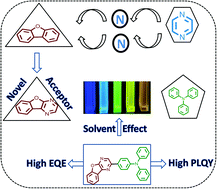A novel electron-acceptor moiety as a building block for efficient donor–acceptor based fluorescent organic lighting-emitting diodes†
Abstract
A new electron-withdrawing moiety (BFPz) has been used for the first time as an acceptor in OLEDs and its corresponding core unit (2-Br-BFPz) was synthesized. Combined with an electron-donating moiety triphenylamine, a novel fluorescent material with a D–A structure named TPA-BFPz was synthesized. Encouragingly, the EQE values of non-doped and doped blue OLEDs reach 3.68% and 4.42%, respectively.


 Please wait while we load your content...
Please wait while we load your content...